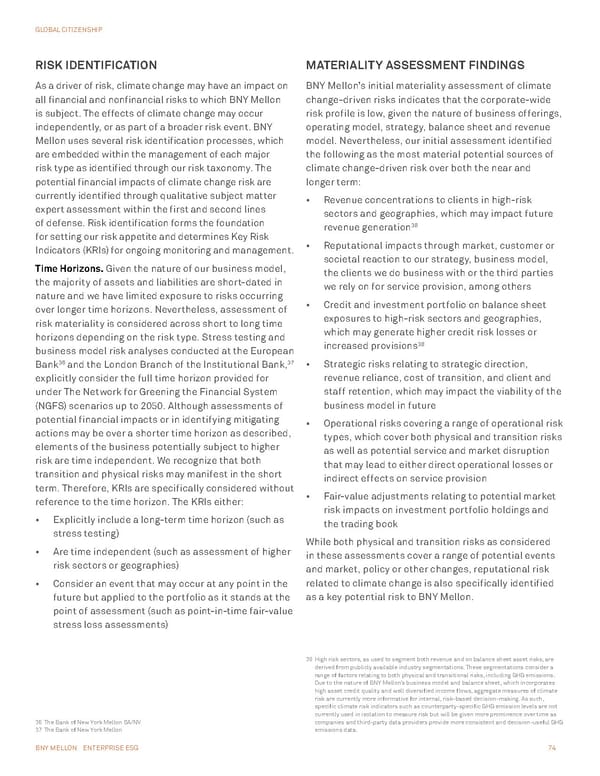BNY MELLON ENTERPRISE ESG 74 GLOBAL CITIZENSHIP RISK IDENTIFICATION As a driver of risk, climate change may have an impact on all financial and nonfinancial risks to which BNY Mellon is subject. The effects of climate change may occur independently, or as part of a broader risk event. BNY Mellon uses several risk identification processes, which are embedded within the management of each major risk type as identified through our risk taxonomy. The potential financial impacts of climate change risk are currently identified through qualitative subject matter expert assessment within the first and second lines of defense. Risk identification forms the foundation for setting our risk appetite and determines Key Risk Indicators (KRIs) for ongoing monitoring and management. Time Horizons. Given the nature of our business model, the majority of assets and liabilities are short-dated in nature and we have limited exposure to risks occurring over longer time horizons. Nevertheless, assessment of risk materiality is considered across short to long time horizons depending on the risk type. Stress testing and business model risk analyses conducted at the European Bank 36 and the London Branch of the Institutional Bank, 37 explicitly consider the full time horizon provided for under The Network for Greening the Financial System (NGFS) scenarios up to 2050. Although assessments of potential financial impacts or in identifying mitigating actions may be over a shorter time horizon as described, elements of the business potentially subject to higher risk are time independent. We recognize that both transition and physical risks may manifest in the short term. Therefore, KRIs are specifically considered without reference to the time horizon. The KRIs either: • Explicitly include a long-term time horizon (such as stress testing) • Are time independent (such as assessment of higher risk sectors or geographies) • Consider an event that may occur at any point in the future but applied to the portfolio as it stands at the point of assessment (such as point-in-time fair-value stress loss assessments) 36 The Bank o f New York Mellon SA/NV 37 The Bank o f New York Mellon MATERIALITY ASSESSMENT FINDINGS BNY Mellon’s initial materiality assessment of climate change-driven risks indicates that the corporate-wide risk profile is low, given the nature of business offerings, operating model, strategy, balance sheet and revenue model. Nevertheless, our initial assessment identified the following as the most material potential sources of climate change-driven risk over both the near and longer term: • Revenue concentrations to clients in high-risk sectors and geographies, which may impact future revenue generation 38 • Reputational impacts through market, customer or societal reaction to our strategy, business model, the clients we do business with or the third parties we rely on for service provision, among others • Credit and investment portfolio on balance sheet exposures to high-risk sectors and geographies, which may generate higher credit risk losses or increased provisions 38 • Strategic risks relating to strategic direction, revenue reliance, cost of transition, and client and staff retention, which may impact the viability of the business model in future • Operational risks covering a range of operational risk types, which cover both physical and transition risks as well as potential service and market disruption that may lead to either direct operational losses or indirect effects on service provision • Fair-value adjustments relating to potential market risk impacts on investment portfolio holdings and the trading book While both physical and transition risks as considered in these assessments cover a range of potential events and market, policy or other changes, reputational risk related to climate change is also specifically identified as a key potential risk to BNY Mellon. 38 High risk sec tors, as used to segment both revenue and on balance sheet asset risks, are derived from publicly available industry segmentations. These segmentations consider a range of factors relating to both physical and transitional risks, including GHG emissions. Due to the nature of BNY Mellon’s business model and balance sheet, which incorporates high asset credit quality and well diversified income flows, aggregate measures of climate risk are currently more informative for internal, risk-based decision-making. As such, specific climate risk indicators such as counterparty-specific GHG emission levels are not currently used in isolation to measure risk but will be given more prominence over time as companies and third-party data providers provide more consistent and decision-useful GHG emissions data.
 BNY Mellon ESG Report Page 73 Page 75
BNY Mellon ESG Report Page 73 Page 75